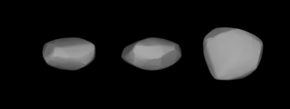Johanna (minor planet designation: 127 Johanna) is a large, dark main-belt asteroid that was discovered by French astronomers Paul Henry and Prosper Henry on 5 November 1872, and is believed to be named after Joan of Arc.[7] It is classified as a CX-type asteroid, indicating the spectrum shows properties of both a carbonaceous C-type asteroid and a metallic X-type asteroid.[6]
 A three-dimensional model of 127 Johanna based on its light curve | |
| Discovery | |
|---|---|
| Discovered by | Paul Henry and Prosper Henry |
| Discovery date | 5 November 1872 |
| Designations | |
| (127) Johanna | |
| Pronunciation | /dʒoʊˈhænə/[1] |
Named after | Joan of Arc |
| A872 VB | |
| Main belt | |
| Orbital characteristics[2] | |
| Epoch 31 July 2016 (JD 2457600.5) | |
| Uncertainty parameter 0 | |
| Observation arc | 98.53 yr (35989 d) |
| Aphelion | 2.94 AU (439.95 Gm) |
| Perihelion | 2.57 AU (384.67 Gm) |
| 2.76 AU (412.31 Gm) | |
| Eccentricity | 0.067041 |
| 4.58 yr (1,671.3 d) | |
Average orbital speed | 17.92 km/s |
| 67.782° | |
| 0° 12m 55.44s / day | |
| Inclination | 8.2449° |
| 31.154° | |
| 94.611° | |
| Earth MOID | 1.60 AU (239.57 Gm) |
| Jupiter MOID | 2.11 AU (315.95 Gm) |
| TJupiter | 3.325 |
| Physical characteristics | |
| Dimensions | 122[2] 116.14±3.93 km[3] |
| Mass | (3.08 ± 1.35) × 1018 kg[3] |
Mean density | 3.75±1.68 g/cm3[3] |
| 12.7988 h (0.53328 d)[2][4] | |
| 0.0557±0.0039[5] | |
| Temperature | ~168 K |
| CX[6] (Tholen) Ch[6] (Bus) | |
| 8.6,[2] 8.30[5] | |
A photoelectric study was performed of this minor planet in 1991 at the Konkoly Observatory in Hungary. The resulting light curve showed a synodic rotation period of 6.94 ± 0.29 hours with a brightness variation of 0.2 in magnitude. It was estimated to have an absolute magnitude of 8.459 ± 0.013 with a diameter of 96–118 km (60–73 mi) and an albedo of 0.06–0.04.[8]
Infrared observations made in 1982 at Konkoly showed a rapid variation that seemed to suggest a shorter rotation period of 1.5 hours; one of the fastest known at the time. However, an irregular shape was suggested as an alternative cause of the rapid variation.[9] The present day established rotation period of this object is 12.7988 hours.[4]
During 2001, 127 Johanna was observed by radar from the Arecibo Observatory. The return signal matched an effective diameter of 117 ± 21 km.[6] A larger diameter value of 123.41 ± 4.07 km was obtained from the Midcourse Space Experiment observations, with an albedo of 0.0557 ± 0.0039.[5] A 2012 study gave a refined diameter estimate of 116.14 ± 3.93 km.[3]
References
External links
- 127 Johanna at AstDyS-2, Asteroids—Dynamic Site
- 127 Johanna at the JPL Small-Body Database